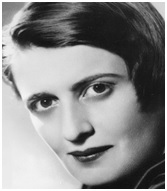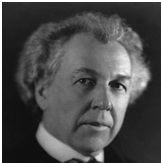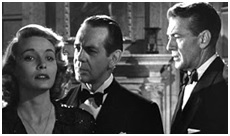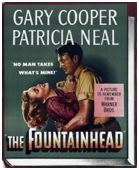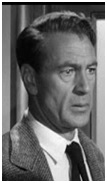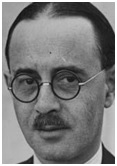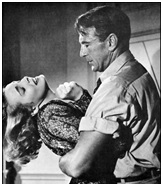|
 |
|
 |
|
|
||
The Fountainhead - Success
The Fountainhead (1943) Written by the Russian-born American female author Ayn Rand (1905-1982), pictured right.
Set in... America 1922-40
Key characters Howard Roark, architect. Peter Keating, his fellow architecture student. Dominique Francon, Roark’s girlfriend and Keating’s wife. Ellsworth Toohey, a socialist journalist. Gail Wynand, Toohey’s newspaper boss.
The story In the spring of 1922, Howard Roark is expelled from architectural school, because he rejected its support of conventional architecture. He goes to New York to work for a disgraced architect, Henry Cameron, who shares Roark’s
passion for unfashionable but beautiful modern architecture. Roark’s fellow student, Peter Keating, graduates and also moves to New York where he joins the prestigious architectural firm of Francon and Heyer. Through flattering his boss (Guy Francon) and designing mediocre architecture, Keating is very successful and quickly becomes a partner. Roark and Cameron create great architecture but receive little recognition for it. After Cameron’s retirement, Roark is hired by Keating who soon fires him for insubordination. After working for another architect, Roark sets up his own business, so that he can create his own designs. He isn’t prepared to sacrifice his architectural ideals, despite winning few customers and being forced to close down. So he works at Guy Francon’s granite quarry in Connecticut. Keating is attracted to Francon’s beautiful daughter and journalist, Dominique, despite his engagement to Catherine Halsey. Dominique meets Roark at the quarry, and they fall for each other. He rapes her in their first sexual encounter. Roark returns to New York to design a new building. Ellsworth Toohey starts a smear campaign against Roark in his architecture newspaper column. Toohey manipulates a businessman to hire Roark for a building (whose nude statue of Dominque causes outrage) and then sue him for incompetence and fraud. Roark loses the case after his architecture is attacked in court by Keating (although defended by
Dominique). Disillusioned by his trial, Dominique convinces herself that she can’t have the world she wants in which the talent of people like Roark is recognized. So she marries Keating (pictured right together with Roark), selling her soul to his world of commercial mediocrity and persuading clients to hire him and not Roark (including Toohey’s newspaper boss, Gail Wynand, who has sex with her). Wynand bribes Keating to divorce Dominique, marries her and befriends Roark after commissioning him to build them a new home. Keating’s subsequent obscurity makes him feel a failure, and he asks Toohey to help get the commission for
Cortlandt Homes, a new public housing development. Roark agrees (anonymously) to design it for
him. Roark is furious when he discovers Keating has changed his design, and, with Dominique’s help, blows up the Cortlandt building which he sees as a betrayal of his architectural vision and ideals. The whole of America condemns Roark. Wynand courageously defends him in his newspapers but finally denounces him because of falling circulation and a union strike by his workers. At his trial Roark is found not guilty after his passionate speech about defending his integrity and the supremacy of the individual. Dominique finally realizes that Roark was right to be true to his design principles, and they start a romance. Despite losing her, Wynand asks Roark to design the world’s tallest skyscraper. Dominique and Roark (now married) meet at the top, when it is nearly finished in the spring of 1940.
Lessons for success 1. Individual first The individual is the source (or “fountainhead”) of all creativity and human achievement. Roark (Gary Cooper in the film, pictured right) is a self-made man who hates anything that gets in the way of his visionary architectural aims:
Roark’s enemy, Ellsworth Toohey, believes that socialist propaganda can overcome:
2. Idealism Roark puts his principles first. He was expelled from architectural school for rejecting conventional professional wisdom. In contrast, Peter Keating sacrifices his principles for money and ambition. To further his career, he marries his boss’s daughter, Dominique Francon, betraying his true love, Catherine Halsey. Dominique, like Roark, believes that professional principles are paramount. But, because of his unprincipled obsession with public opinion, Gail Wynand loses his
3. Hate mediocrity Roark attacks the poor standard of conventional architecture even at the expense of:
He employs employees who believe in his values of:
For example, he tells his sculptor, Steven Mallory “to seek the best”. But Ellsworth Toohey (inspired by the British socialist, Harold Laski, pictured right) wants to achieve socialism through:
“Enshrine mediocrity”, he says.
4. Be true to yourself Unlike Peter Keating, Roark and (eventually) Dominique remain true to their vision, values and ideals.
5. Be creative and innovative Roark and Dominique are dedicated to new modern architecture that depends on
This freedom of thought is attacked by Ellsworth Toohey who wants “a world where the thought of each man will not be his own, but an attempt to guess the thought of his neighbour”.
6. Be responsibly assertive Roark fights for and fiercely defends what he wants in life:
But such assertiveness must not turn into violent aggression (as shown by Roark’s rape of Dominique, pictured right).
Key quote on success I came for a simple, selfish reason...to seek the best, Roark (asking Steven Mallory to work with him). I’ve been a parasite all my life...I have taken that which was not mine and given nothing in return, Keating
Key quote on influencing people Tell man that he must live for others. . . . Not a single one of them has ever achieved it and not a single one ever will, Toohey (on the importance of individual self-interest and liberty that Toohey says can be overcome by socialist propoganda).
Two literature websites to recommend 1. sparknotes.com 2. litcharts.com
|
|
|
||
|
|
||
| Copyright © wisdomtowin.com 2025 All Rights Reserved | ||
|


